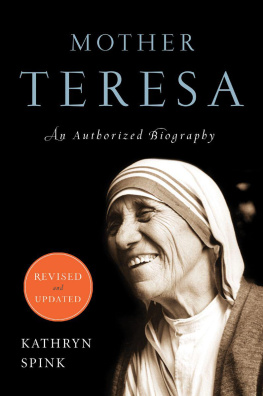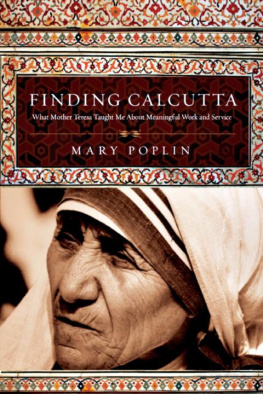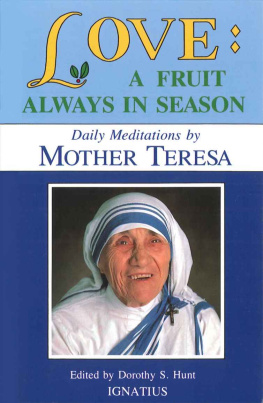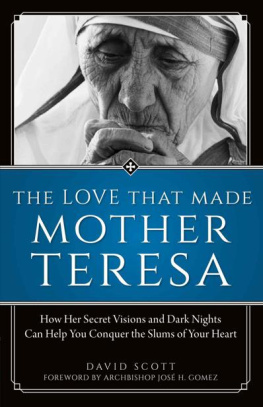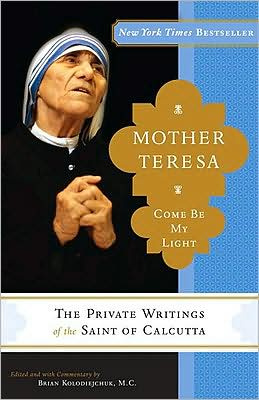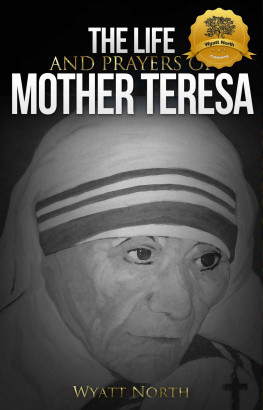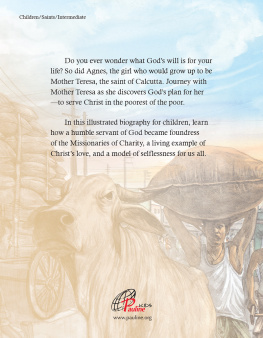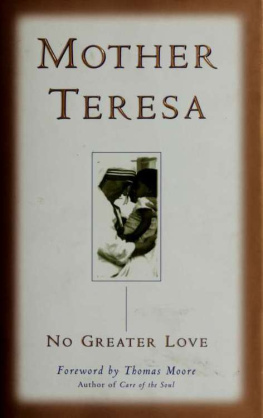MOTHER TERESA
An Authorized Biography
REVISED AND UPDATED
Kathryn Spink

This book is dedicated to the memory of Mother Teresa, Ann Blaikie, Bunty Watts, and Father Van Exem, to all of whom I owe an immeasurable debt of gratitude. I would also like to express my appreciation to the many otherssisters, brothers, co-workers, and prieststhroughout the world who have given of their time, talents, hospitality and insight in the preparation of this book. To Cherry Fisher; to John Pawsey, my agent; and to all the friends and companions of my journey too numerous to mention individually here, my warmest thanks. To one of them in particular I can pay no more appropriate tribute than to say that she sought at great personal cost to create, as Mother Teresa would have wished, something beautiful for God.
Contents
My first contact with Mother Teresa was in 1980, via a crackling telephone line from London to Calcutta. I had discovered, in a battered tin trunk belonging to one of her earliest lay helpers, the unofficial archives of her international mission. By then that mission consisted of the Missionary Sisters of Charity, a similar order for men, contemplative branches of the two congregations, spiritual links with over four hundred enclosed orders of different denominations, and an association of several thousand helpers, or Co-Workers, scattered over five continents. The records then of what Mother Teresa had on more than one occasion referred to with a certain satisfaction as the most disorganized organization in the world consisted of already-yellowing letters, articles, and snippets of paper thrown together by a stroke of vague foresight. Yet they reflected, it seemed to me, at very least a story of extraordinary growth in the thirty-two years since a solitary woman had stepped out into the slums of Calcutta to live among the poorest of the poor as one of them.
For three nights in succession I sat up into the early hours of the morning, trying to make contact with Mother Teresa. On the third attempt she answered the telephone herself, as was her general practice at night when she was at the motherhouse in Calcutta. By then Malcolm Muggeridge had written Something Beautiful for God, the book that was to open the eyes of the world to the work of Mother Teresa and her Missionaries of Charity, and there had been a few others. It was enough, Mother Teresa told me. There was no more material. But with all the irritability of one who has lost too much sleep, I presumed to argue. Unwilling perhaps to be unkind, she conceded that we could meet when next she came to London. We did so, and in the sparsely furnished parlor of the sisters London home I experienced for the first time her gift for giving her whole attention to the person she encountered. She gave me her permission to write, telling me that I did not have to ask, and adding that she hoped that I was not putting any of my own money into the venture. Apparently, Nobel laureate though she was, she had no inkling that her consent to that, my first real book with all its defects and limitations, would be enough to launch my career as a writer. I did not know it then but would afterward discover that precisely those qualities that in this worlds terms might well have counted against me were what contributed to the favorable outcome of our encounter: my youth, my inexperience, my sense of inadequacy and uncertainty.
During the years that followed we would meet on numerous other occasions in India, England, France, Rome, in a colored township outside Cape Town, in just a few of those locations that her own distinctive geography of compassion had determined as places where the abandoned poor needed the particular care of the Missionaries of Charity. I witnessed not only the love and the luminous smile for which she became increasingly internationally renowned but also her practical abilities, the way in which she liked to rearrange the furniture in the sisters houses, the efficiency that meant that somehow everything was perfectly organized and administered without any organization or administration, the lack of sentimentality and the immense shrewdness that went hand in hand with intuitive understanding, the earthy qualities that did not detract from her spirituality but that were somehow molded by it. I came to know her humor and her toughness. She was, I discovered, not only humble and small but also strong-willed, resolute, determined, and totally fearless, because God was on her side. This assumed union of intention was not one with which everybody easily came to terms. What Mother wants, she gets was a truism widely accepted among those who knew her. It was accepted because the strength of her conviction had so manifestly been instrumental in the achievement of extraordinary results, because of the love she both gave and inspired, and because her own heart, which saw and knew everything, forgave everything also. In some mysterious way she lit up everyone and everything she encountered.
Even a ride in a transit van through the dusty, congested streets of Calcutta in the company of one who was widely known there simply as Ma or Mother could be a transforming experience. Always it would begin and end with communal prayer, the saying of the rosary. There were unaffected gestures of greeting for those passersby who, recognizing the distinctive white sari with the blue border and the well-known stooping shoulders, would pause to look. At intervals the furrows of her face would dissolve into an all-embracing smile in response to their smiles or at some humorous thought, at the possibility, for example, that in the company of both her and her sisters I might be taken for a postulant. All the time the strong, disproportionately large hands would continue to work their way silently through the rosary beads. For Hindus simply to be in the presence of a holy person brings with it a darshan, a form of blessing. For this reason crowds struggled miles during the lifetime of Mahatma Gandhi to catch a distant glimpse of Indias Great Soul, and for this reason now rich and poor alike sought the company or merely the presence of Mother Teresa. I came to respect this concept of darshan for, skeptic that I potentially was, I never left her presence without feeling better, uplifted, somehow blessed. Like the lepers on the pavements of Calcutta, somehow I too walked more sure-footedly beneath her gaze.
Her dedication moved both the materially poor and the powerful, irrespective of race or religious creed. I have seen people weep at her leaving though they have met her only at a distance across a crowded room. Indias late premier, Jawaharlal Nehru, inaugurating Mother Teresas first childrens home in Delhi in 1961, could not conceal the emotion in his voice as he told her: Believe me, Mother, we need you just as the poor do. Senator Edward Kennedy, who saw her work in Calcutta during the 1971 Bangladesh war, shed public tears. When Lord Runcie, then archbishop of Canterbury, visited the Missionaries of Charity in Calcutta in December 1986, he was reported to have wanted to kneel and kiss Mother Teresas feet. It had been, he said, the most humbling and uplifting experience of my life. He was by no means alone in expressing such sentiments.
In February 1991 I went to Calcutta once again to ask Mother Teresas permission to write. On the bench outside the chapel overlooking the courtyard of the motherhouse I waited and watched as a procession of people from all over the world packed the corridor and stairway in the hope of speaking to her or simply of touching her feet. Mother Teresa was eighty years old. Her five-foot frame was severely bent. Her health was far from robust, and a pacemaker had been fitted to counteract a heart condition. She looked frail and her voice was weaker. The blue-gray eyes had lost a little of their penetration. Yet the influence of this tiny woman was still very much in evidence. Small notes written by hand and signed Mother, gave directives relating to the most ordinary of practical details. The central courtyard of the motherhouse contained two tanks of water. Sisters, please do not keep anything on top of the tank, a carefully handwritten note appealed, Thank you, Mother. It was during a period of intense international tension that preceded the Gulf War. Outside the chapel a copy of a letter Mother Teresa had written to Presidents George Bush and Saddam Hussein, appealing to them to choose the way of peace, bore witness to the role she was still playing on the world scene:
Next page
